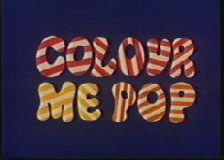
TV Pop Diaries
Pop Music on British Television 1955 -
BBC2's daily cultural review show Late Night Line-
Ayres would be given the job title of editor, rather than producer. That title would go to Steve Turner who previously had been a vision mixer on many classic BBC TV comedy shows like Hancock and Steptoe and Son. Turner himself had little interest in pop music before embarking on the show. Talking to Melody Maker in September 1969 he admitted "... my main interests are light classical music, church, and organ music" which he felt helped him approach the show with an open mind "I therefore worked that much harder to understand the whole scene." Turner was given a free hand to create the show, but given a small budget and an even smaller studio, 20 by 30 feet. The first shows were broadcast live, but this was considered unsuccessful, so later shows would be taped and edited together.
The "colour" aspect of the title would be obvious as BBC2 was the only colour channel in the UK at the time and seeing the great British bands of the time in colour was a wonderful novelty if you had one of the very expensive colour TVs, costing around £300 at the time if you didn't rent one.
It was not initially seen as a show in its own right, just a part of Late Night Line-
According to press accounts ahead of the first show there would have been two flavours of the show, Colour Me Pop and Colour Me Jazz, depending on the content, but the jazz element would be dropped before the first broadcast.
Featured acts were given thirty minutes to play live (or singing live to the backing
track) in the studio each week with occasional forays to the exotic location of The
Fairfield Hall, Croydon for several live sets recorded on the 29th September 1968
as a Mexico Olympic Games fundraiser (the games would take place the following month.)
There would also be some other location filming, with Clodagh Rodgers wandering around
derelict buildings in a mini-
The show recognised that albums were now taken seriously as a new musical format in its own right, rather than just a collection of songs or a studio recreation of the band's live set, but thankfully the acts were allowed to get on with performing with no silly interviews about the meaning and motivation for what they were doing. Among those who paid a visit were The Small Faces, The Hollies, The Kinks, The Move, The Moody Blues, David Ackles, Eclection, Fleetwood Mac and many others. However, the show wasn't just given over to the progressive tendency, with time given to a few pop acts like Clodagh Rodgers and The Fortunes. The show was also important in giving much needed exposure to many second division bands on smaller labels who would have been excluded from Radio One playlists otherwise.
Despite his worry that the show would be taken off "after the first four weeks" Turner's production skills resulted in a fifteen month run.
Having won the Top TV Show award in the Melody Maker poll in September 1969, beating
Top Of The Pops, it was assumed that the show would return, but the BBC had no plans
to do so. A re-
Two retrospective compilation shows were assembled in 1969/70, but that would be
the last anyone saw. Turner would go on to produce the shows' descendent Disco 2.
Sadly, there was no tie-
Several of the few surviving shows have been released on DVD and CD, while an excellent article on the show, written by Adam James Smith appeared in issue 92 of Shindig.
COLOUR ME POP
BBC2
18th May 1968, 14th June 1968 -
